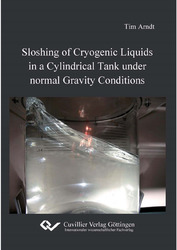| Fachbereiche | |
|---|---|
| Buchreihen (96) |
1378
|
| Nachhaltigkeit |
3
|
| Gesundheitswesen |
1
|
| Geisteswissenschaften |
2364
|
| Naturwissenschaften |
5406
|
| Ingenieurwissenschaften |
1793
|
| Allgemeine Ingenieurwissenschaften | 292 |
| Maschinenbau und Verfahrenstechnik | 862 |
| Elektrotechnik | 686 |
| Bergbau- und Hüttenwesen | 30 |
| Architektur und Bauwesen | 75 |
| Allgemein |
98
|
|
Leitlinien Unfallchirurgie
5. Auflage bestellen |
|
Erweiterte Suche
Sloshing of Cryogenic Liquids in a Cylindrical Tank under normal Gravity Conditions
Tim Arndt (Autor)Vorschau
Inhaltsverzeichnis, Datei (33 KB)
Leseprobe, Datei (310 KB)
Particularly in the upper stage development of rockets (launchers), gravity dominated fluid motion in upper stage tanks (sloshing) during flight represents an undesired dynamic effect. On the one hand the sloshing forces lead to disturbances, which have to be compensated by the reaction control system. On the other hand, when cryogenic fluids are considered, the fluctuations in tank pressure may be critical under some circumstances compromising the structural stability of the tank. In this field, the utilization of cryogenic propellants represents a high challenge to layout and design of the propulsion components including the propellant tanks.
This work deals with two effects that are directly coupled to the sloshing content inside the propellant tank. To investigate these effects a dedicated test setup has been developed. At first, the damping characteristics of sloshing cryogenic nitrogen – which is used as a substitute for the rocket propellants liquid hydrogen and liquid oxygen – are determined. The results are correlated to the theory based on storable propellants. The main part of this work is linked to a characteristic pressure drop inside the propellant tank caused by the sloshing liquid. For the effect to occur, the tank must be pressurized to enable the formation of a thermal stratification below the liquid surface. Sloshing leads to the mixing of liquid in this region with subcooled liquid from the bulk. This affects the decrease of the temperature at the free surface leading to the condensation of superheated vapor. Thus, the pressure in the tank must decreases. Three different pressurization concepts are introduced in this work; self-pressurization where the tank is pressurized by evaporating liquid caused by the heat flowing into the tank. Furthermore, the tank is pressurized with gaseous nitrogen taken from an external gas bottle and at last gaseous helium from an external supply is used for pressurization purpose. By the application of helium as non-condensable gas, a significant reduction of the pressure drop is expected. The experimental results confirm this working hypothesis and therefore support the theoretical considerations described by an approach of Das & Hopfinger.
All results are presented in a non-dimensional form to allow the comparison to data from the literature. Furthermore, the upscaling of the current results enables the prediction for future cryogenic upper stages such as the ESC-B for the European space launcher Ariane 5.
| ISBN-13 (Printausgabe) | 3954041243 |
| ISBN-13 (Printausgabe) | 9783954041244 |
| ISBN-13 (E-Book) | 9783736941243 |
| Buchendformat | A5 |
| Sprache | Englisch |
| Seitenanzahl | 212 |
| Umschlagkaschierung | matt |
| Auflage | 1 Aufl. |
| Erscheinungsort | Göttingen |
| Promotionsort | Bremen |
| Erscheinungsdatum | 04.06.2012 |
| Allgemeine Einordnung | Dissertation |
| Fachbereiche |
Allgemeine Ingenieurwissenschaften
|








